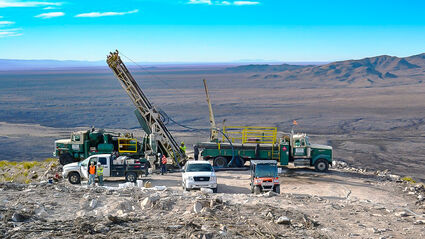Texas JV moves quickly on REE separation
Round Top partners open pilot plant that meets Army request North of 60 Mining News – December 20, 2019
Last updated 9/26/2020 at 11:31am

Texas Mineral Resources Corp.
A drill tests the Round Top rare earth and critical mineral project about 85 miles southeast of El Paso, Texas.
USA Rare Earth LLC and Texas Mineral Resources Corp. has made a major advancement toward developing the heavy rare earth separation technology that the U.S. Army is looking to invest in.
The Army recently sent memos requesting information on the costs to develop separation facilities that can produce heavy rare earths, which tend to be the least abundant but most highly prized of the 17 elements considered rare earths.
Further details on the Army memos and Pentagon's push to establish a rare earth element (REE) supply chain in the United States can be read at Army probes rare earth facility funding, published in the Dec. 13 edition of North of 60 Mining News.
Texas Mineral Resources and USA Rare Earth have opened a pilot plant facility in Wheat Ridge, Colorado to separate the rare earths and other critical minerals found at their Round Top project about 85 miles southeast of El Paso, Texas.
Texas Mineral Resources is the El Paso-based exploration company targeting the heavy rare earths and other technology metals and industrial minerals found at Round Top, and USA Rare Earth is a New York City based company that is funding the project's development.
According to a preliminary economic assessment published in July, a mine at the Round Top project in Texas would produce 2,212 metric tons of rare earths per year, including healthy supplies of all six permanent magnet rare earth oxides. This includes more than 200 metric tons of dysprosium, 23 tons of terbium, 65 tons of gadolinium, 65 tons of samarium, 180 tons of neodymium and 67 tons of praseodymium once the mine reaches full production.
According to current calculations, the west Texas deposit is large enough to supply REEs at this rate for more than a century.
Currently, however, there are no facilities in the U.S. capable of separating the rare earths into the individual metals that can be used in high-tech and military devices.
The one REE mine that operates in the U.S., Mountain Pass in California's Mojave Desert, ships its concentrates to China for further processing. China, in turn, often manufactures the individual rare earths into magnets and other higher-end products needed by the U.S. high-tech and national defense sectors.
"The development of advanced processing methods is a necessary step in re-establishing a domestic supply of these strategic metals and end the United States dependency of China for both the supply and downstream methodology associated with them," said Texas Mineral Resources Chairman Anthony Marchese.
This is what the Round Top partners hope to accomplish with the pilot plant in Colorado and eventual full-scale separation facility near their proposed mine in Texas.
The pilot plant will use continuous ion exchange and continuous ion chromatography to pull out the rare earths and other critical elements from a solution produced through the leaching of the mineralized material at Round Top.
This ion-exchange process works at the molecular level to separate individual metals from solution.
Developed by the Manhattan Project in the 1940s, continuous ion exchange was originally used to refine actinide series elements such as uranium, plutonium and thorium. At the time, the more benign lanthanide metals, which makes up 15 of the rare earth elements, were used for testing the process.
Solvent extraction was later developed as a means to separate rare earths on a larger scale and is the method that is currently used in China.
The ion exchange process, however, was later adapted to many other high-volume industrial uses and came into its own with the advent of the "continuous process" in conjunction with its cost-effectiveness, simplicity of operation and versatility.
Under a Defense Logistics Agency grant, Texas Mineral Resources has already demonstrated that the continuous ion exchange and continuous ion chromatography process, which has a smaller footprint and uses less chemicals than solvent extraction, can produce greater than 99.99 percent pure rare earths from a solution derived from Round Top.
Now the Round Top partners are scaling up this REE separation process at the Colorado pilot plant in Wheat Ridge, a Denver suburb.
"The Wheat Ridge pilot plant is the second piece of a 100 percent U.S.-based rare earth oxide supply chain, drawing on feedstock from our Round Top heavy rare earth deposit in southwest Texas," said USA Rare Earth CEO Pini Althaus. "Taken together, we believe Round Top and our pilot plant constitute essential links in restoring a domestic U.S. rare earth supply chain, extracting rare earths and processing them into individual REE oxides – without the material leaving the United States – thereby alleviating the current dependence on China for both raw materials and mineral processing."
This would also meet the Pentagon's objective of establishing a domestic supply chain for the REEs needed for military hardware.
It would also provide America's high-tech sector with a domestic option for the metals required for high-end electronics, electric vehicles and green energy.

Peggy Greb, U.S. Department of Agriculture
Rare earths consist of 15 lanthanides, yttrium and scandium, elements that are increasingly important ingredients to a growing number of high-tech devices and military hardware. Clockwise from top center: praseodymium, cerium, lanthanum, neodymium, samarium, and gadolinium.
"Aside from Round Top's potential to supply material for U.S. defense as well as commercial applications, our initiative could reinvigorate advanced domestic technology manufacturing in the U.S. and provide companies currently doing business overseas with a viable alternative."
In addition to the suite of rare earths, a mine at Round Top would produce appreciable amounts of lithium, hafnium, zirconium, gallium and beryllium, all metals considered critical to the economy and national security of the United States.
EDITOR'S NOTE: Look for further coverage of Texas Mineral Resources, USA Rare Earth and the Round Top project in Metal Tech News, a technology metals and mining technology publication being launched by the North of 60 Mining News team on Jan. 1, 2020 at https://www.metaltechnews.com/.

















Reader Comments(0)